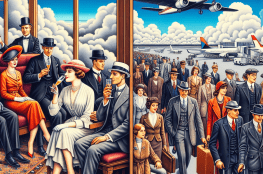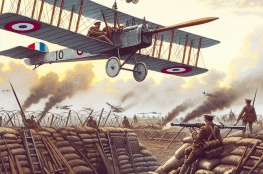From Canvas to Jet Engines: Evolution of Aircraft Technology
When Orville and Wilbur Wright took to the skies in 1903 with their canvas-covered Wright Flyer, little did they know that they were taking the first step toward transforming transportation on a global scale. Fast forward to today, aircraft propel through the air with the grace of an albatross, powered by engines that generate thrust with the force of millions of horsepower. Let’s explore the fascinating journey from flimsy airframes to sophisticated jet engines.
The Dawn of Aviation: Canvas and Wood
The early 20th century was synonymous with innovation as inventors around the world raced to conquer the sky. The Wright Brothers’ Flyer was the quintessential example of this; it was a fragile structure made of spruce, with its wings covered in muslin. Not exactly the kind of luxury most frequent flyers might expect today!
- Power Source: The Flyer was powered by a 12 horsepower gasoline engine.
- First Flight: It reached speeds of about 10 mph, the kind of speed you might achieve if you were particularly late for a dinner date.
- Distance Travelled: The first flight traveled only 120 feet – less distance than a modern airplane covers during taxiing to the runway.
Metal Takes Flight
As technology marched on, wooden frames evolved into metal ones, providing greater strength and durability. This metal age was spearheaded by aircraft such as the Ford Trimotor and the DC-3, which were not only more robust but also could carry more passengers and cargo.
By the 1930s, aircraft design had made significant strides. The engines got more powerful, airframes more robust, and the altitudes higher. However, metal aircraft still cruised nowhere near the speeds travelers are used to today. The arrival of World War II, though, would mark a pivotal turning point in aircraft technology.
Jets and Beyond: The Advent of Modern Aviation
The post-war era ushered in jet engines, an invention that revolutionized every aspect of aviation. The transition from propeller-driven aircraft to jet engines brought speed, efficiency, and reliability – traits that persist in modern aviation.
- De Havilland Comet: The first commercial jet airliner, which made its debut in 1952, accelerating air travel immensely.
- Boeing 707: Introduced intercontinental travel, shrinking the globe metaphorically if not literally.
- Concorde: This supersonic marvel of the 20th century stoked imaginations and broke barriers with speeds over Mach 2.
Just when you thought aviation couldn’t get cooler, in swoops the aviation industry with its latest innovations. Modern jets tear through the sky with stunning efficiency, powered by engines producing over 100,000 pounds of thrust.
What’s Next: The Future of Flight
Today, the industry is buzzing with talk of electric aircraft, drones, and even passenger-carrying space vehicles. The evolution of aircraft technology does not only influence how we swim through the skies but also how we work and even learn.
With abundant educational resources available to explain these technologies, such as Popular Education Channels on Telegram, enthusiasts can dive deeper into how aircraft fly and understand more about what makes these technological wonders tick.
Conclusion
From ragtag canvases taking baby steps off the ground to powerful jet engines roaring passages across the heavens, the journey of aircraft technology is an awe-inspiring tale of human ingenuity. Whether you’re an aviation enthusiast or a curious observer, there is always something to learn about the sky-high achievements that have turned dreams of flight into an everyday reality. Who knows what the next chapter holds—perhaps one where aircraft technology makes air travel as speedy as your morning commute!
So, buckle up, and keep your eyes on the skies for the latest evolution in the fascinating world of air travel.



